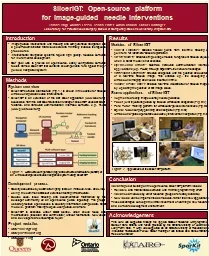

USG needle interventions such as central venous catheterization CVC require simultaneous sonography and needle placement Ideally novices should master this skill in a simulated setting prior to progressing to the clinical realm in order to minimize risk Thus ID: 910256
Download Presentation The PPT/PDF document "Introduction Motivation Ultrasound-guide..." is the property of its rightful owner. Permission is granted to download and print the materials on this web site for personal, non-commercial use only, and to display it on your personal computer provided you do not modify the materials and that you retain all copyright notices contained in the materials. By downloading content from our website, you accept the terms of this agreement.
Slide1
Introduction
Motivation
Ultrasound-guided
(USG) needle interventions, such as central venous catheterization (CVC), require simultaneous sonography and needle placement.
Ideally novices should master this skill in a simulated setting, prior to progressing to the clinical realm, in order to minimize risk. Thus, it is essential to determine the quantity of practice required to achieve competence in such interventions.ObjectiveThe objective of this work is to use objective performance metrics to track novice learning curves and to determine the amount of practice required to achieve technical proficiency in USG CVC insertion in a simulated environment.
Central Venous Catheterization Curriculum Development via Objective Performance Metrics
Matthew S. Holden1, Mark Woodcroft2, Tim Chaplin2, Louise Rang2, Melanie Jaeger3,Nici Rocca2, Robert C. McGraw2, Gabor Fichtinger1, Tamas Ungi11School of Computing; 2Department of Emergency Medicine; 3Department of AnaesthesiologyQueen’s University, Kingston, Canada
Methods
Study ProtocolFour PGY-2 emergency medicine residents and four PGY-2 anaesthesiology residents participated in three CVC training sessions at two week intervals (Fig. 1). Participants practiced USG CVCs on simulation phantoms (CAE Healthcare, Montreal, Canada, www.bluephantom.com), and were provided specific guidance, feedback, and drills by experts. Before and after each training session, participants performed a tracked intervention.Hand motion analysis and performance metric computation were performed using the Perk Tutor training software (www.perktutor.org; Fig. 2) [1]. Resident learning curves were monitored via performance metrics and compared to expert benchmarks [2].Objective Performance Metrics
Results
At baseline, all performance metrics were significantly different between the novice and expert groups, providing evidence for construct validity [1]. Our quantitative data suggest that three training sessions totalling 85 simulated procedure attempts is sufficient for novices to achieve technical proficiency in simulated USG CVC insertion (Fig. 3). Based on direct observation by experts, residents had the most difficulty with needle tip visualization and were assigned drills to reinforce this skill.At the end of the third session, for the first time, both the trainees’ path length and number of hand motions surpassed the expert benchmarks (p = 0.018, p = 0.010, respectively for Wilcoxon signed-rank test). These results suggest that three sessions are sufficient for achievement of technical proficiency. The trainees’ procedure time approached, but did not yet surpass the expert benchmark.
Conclusion
Using performance metrics, we were able to objectively establish novice learning curves and determine the quantity of training required for novices to achieve technical proficiency in simulated USG CVC insertion: 85 practice attempts over three sessions. This demonstrates that performance metrics, such as those implemented in the Perk Tutor, can be a valuable tool for procedural task curriculum development.
References & Acknowledgements
T. Ungi, et al., "Perk Tutor: An Open-Source Training Platform for Ultrasound-Guided Needle Insertions," IEEE Transactions on Biomedical Engineering, vol. 59, no. 12, pp. 3475-3481, Dec 2012. D. Clinkard, et al., "The Development and Validation of Hand Motion Analysis to Evaluate Competency in Central Line Catheterization," Academic Emergency Medicine, vol. 22, no. 2, pp. 212-218, 2015.Matthew S. Holden is supported by the NSERC Canada Graduate Scholarship. Gabor Fichtinger is supported as a Cancer Care Ontario Research Chair in Cancer Imaging. This study was made possible through the financial support of a Southeastern Ontario Academic Medical Organization (SEAMO) Innovation Fund Grant. This work was in part funded by Cancer Care Ontario through Applied Cancer Research Unit and Research Chair in Cancer Imaging grants.
Procedure Time (s)The total amount of time taken to complete the intervention.Path Length (mm)The combined length of the path swept out by the needle and ultrasound probe.Number of Hand MotionsThe combined number of distinct motions made by the left and right hands.
Figure 1.
Photograph of experimental setup with trainee performing a USG CVC with hand tracking.
Figure 2. Screenshot of performance metric computation using the Perk Tutor software.
Figure 3.
Trainee learning curves for procedure time (top-left), path length (top-right), number of hand motions (bottom) versus session number (B = Beginning, E = End). Black lines indicate the novice mean for each session. Grey dashed line indicates the expert benchmarks.